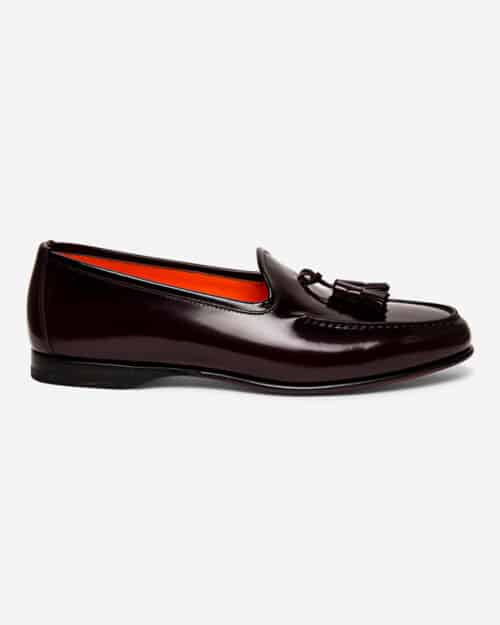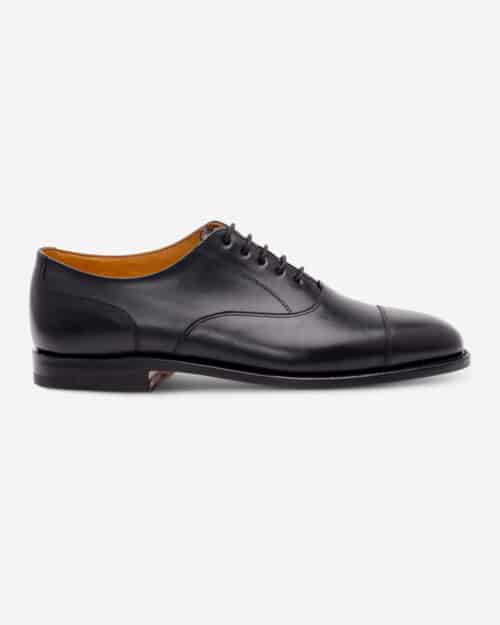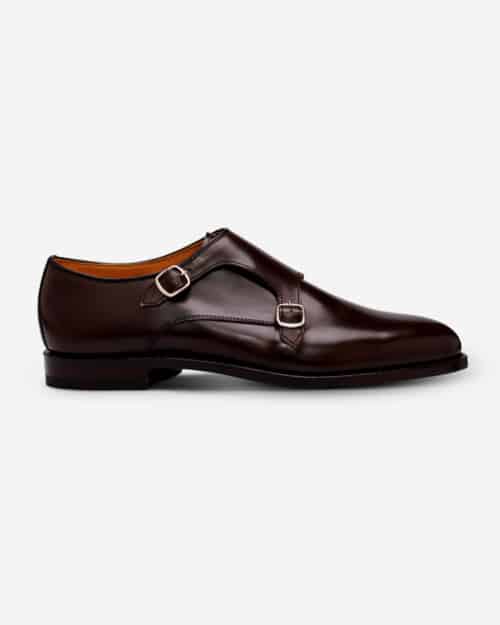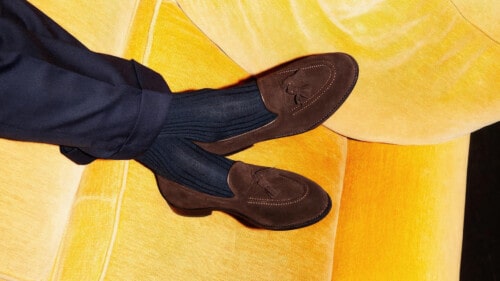
The Ultimate Guide To Men’s Dress Shoes
Sharp, sophisticated and timeless, luxury dress shoes are the pinnacle of shoemaking, giving your wardrobe an inherent sense of class and refinement.
Luxury dress shoes are the epitome of elegance and refinement, embodying the perfect harmony of craftsmanship, materials and prestige. Through the use of premium calfskin, intricate Goodyear-welted construction and the skilled hands of master craftsmen, these shoes are elevated to a level that surpasses ordinary footwear.
Good shoes are good shoes, but great shoes are works of art, and stand testament to the timeless allure of handmade excellence.
So, when you step into a pair of high-end dress shoes, you are not just putting on footwear; you are embracing a tradition of refinement and sophistication that will accompany you for decades (quite literally if you take care of them properly).
While your wardrobe doesn’t need to house every style of dress shoe ever conceived, it’s a good idea to at least have a couple of different variants in your sartorial arsenal.
Below we’ve put together an essential guide to ensure you make the correct decisions next time you’re in the market for formal footwear.
What makes a quality dress shoe?
What separates run-of-the-mill dress shoes and luxury dress shoes is craftsmanship. The latter go through a meticulous handcrafted manufacture.
What makes them truly luxurious lies in the intricate details, the quality of materials used, and the prestigious artistry that goes into their creation…
Fine leather
At the heart of every quality dress shoe is the use of exquisite leather. Premium calfskin, sourced from the finest tanneries, is often the material of choice.
Known for its supple texture, durability and ability to develop a beautiful patina over time, calfskin ensures both comfort and longevity, a hallmark of luxury footwear.
Otherwise, look out for buttery-soft suede options, too. Most dress shoes will also come with leather soles, rather than rubber ones, affording you the option to easily replace them when worn.
Goodyear-welted construction
One of the most revered construction methods for any high-end pair of shoes is the Goodyear welt. This technique, invented over a century ago, involves stitching the upper, insole and outsole together using a strip of leather called the welt. This meticulous process results in a shoe that is not only durable but also allows for easy resoling, extending the lifespan of the footwear.
Goodyear-welt construction ensures exceptional comfort, stability and flexibility, setting it apart from cheaper production methods. There is only one alternative that is arguably better than Goodyear-welted construction and that is hand welted, which is only reserved for bespoke shoes and requires a huge amount of skill from the artisan.
Another common method you will come across includes the Blake stitch, which is where the upper is stitched directly to the sole of the shoe, giving it a lighter and more flexible feel than Goodyear-welted models.
Handcrafted excellence
From the hand-cutting of the leather to the hand-stitching of the upper, every step of luxury dress shoe manufacture is executed with precision and expertise.
This level of craftsmanship, in keeping with the shape of the house blocks, allows for a perfect fit and unmatched comfort.
Beyond leather
While leather is the cornerstone of luxury dress shoes, other materials are often incorporated to enhance their appeal.
Fine details such as hand-painted patinas, exotic accents (such as crocodile or lizard skin) and intricate brogueing patterns are all used to elevate the aesthetic.
Key types of dress shoes
The Oxford
The Oxford is the epitome of formal footwear, characterised by its closed-lace construction, where the vamp is sewn over the quarters.
They originated in Scotland and gained popularity in England during the 19th century, becoming the go-to choice for black-tie events, business attire and formal occasions.
With a sleek and streamlined appearance, the Oxford comes in a couple of subtle variants, the most common being the cap toe style, which features – you guessed it – a capped toe.
Another version is the wholecut Oxford, which is cut from a single piece of leather and often the style used for hand-painted patinas.
The Derby/Blucher
The Derby, also known as the Blucher (named after a US field marshal who assisted Wellington in the defeat of Napoleon at the Battle of Waterloo, and who was fond of kitting his soldiers out with this style of shoe), features an open-lace construction, with the quarters sewn on top of the vamp.
This design offers a more relaxed and versatile option compared to the smarter Oxford. it’s not that you can’t wear a Derby with a suit or smart separates, but typically speaking it is more casual leaning and you should be aware of this.
The monk strap (single and double)
The single monk-strap shoe showcases a distinctive single buckle closure, usually positioned on the side of the shoe, and has soared in popularity over recent years thanks to brands such as Santoni, which has produced some great lines in the style.
It’s essentially a cap toe Derby but fastened with a strap and single buckle, or in the case of the double monk, a double buckle.
They typically have a lightweight construction and thin soles, making them a great option for people who want to add some flair to their business suits or separates combinations.
The loafer
The loafer is a versatile slip-on shoe that comes in many guises today, from luxurious Belgian loafers to chunky fashion-forward contemporary styles.
They originated in Norway, where they are purported to have been worn by fishermen when back on shore, and gained popularity in the United States during the mid-20th century thanks G.H. Bass, which famously marketed them as ‘Weejuns’.
As far as dress shoes go they are a bit of an anomaly, because the loafer neatly traverses both smart and casual style. Variants such as the penny, tassel and horsebit loafer look just as good worn with suits and separates as they do casual shorts and tees, which is what makes them such a great shoe to have in your arsenal.
Available in a range of leather and suede styles, the loafer is typically better at bookending your spring and summer outfits, while chunkier rubber-soled options are a good choice for contemporary winter looks.
The brogue (and its various iterations)
Brogues are dress shoes characterised by decorative perforations and wingtip detailing. They come in various styles, including Oxfords, Derbies and boots.
Brogueing originated in Scotland and Ireland, initially designed for practical use in wet terrains where the shoes were punched with holes to allow the water to escape from inside. Over time, they evolved into stylish footwear suitable for formal and semi-formal occasions.
There are a few different types of brogueing that you’ll see over and over again. The most prevalent is the wing-tip brogue, which features an M-shaped pattern of brogueing on the upper. This is most commonly found on Oxfords, which is also the style of shoe typically used for semi-brogueing, where the punched detail run along the seam of the toe cap.
An alternative is the long-wing brogue, which has the intricate punched detail running right the way back to the heel of the shoe. As a rule of thumb, the less brogueing a shoe has, the smarter it is.
The best luxury dress shoe makers for men
John Lobb
Now under the ownership of Hermès, John Lobb is a renowned British shoemaker established in 1849, and the preferred brand of King Charles.
With a bespoke atelier in Paris and a workshop in Northamptonshire, the company has been synonymous with exceptional craftsmanship and luxurious footwear for over 170 years.
It does an exceptional line of classics, exemplified by styles such as the Phillip II cap-toe Oxford, as well as an eclectic range of stunning summer shoes in buttery soft suede hides.
George Cleverley
Founded in London in 1958, George Cleverley has earned a long-standing reputation for creating some of the world’s finest handmade shoes.
Now under the guidance of George Glasgow Jr and his father, Cleverley is renowned for its elegant designs, flawless construction and dedication to preserving traditional craftsmanship.
It also supplied all of the shoes for the Kingsman films. Style-wise, it’s best known for its subtle squared-off toe shape.
Edward Green


One of the most respected icons of the Northamptonshire shoemaking community, Edward Green has been making stunning handmade shoes since 1890.
The brand has maintained its reputation for over a century, consistently delivering shoes that exemplify classic British style and exceptional quality.
This level of quality comes at a cost but every Green shoe is an investment. What’s more, the company only produces around 250 pairs of shoes per week due to the meticulous handmade process.
With a number of stunning lasts to choose from, a pair of Edward Green shoes is a significant and special addition to your wardrobe. The Piccadilly unlined loafer is a house favourite in the summer, while its Chelsea cap-toe Oxfords are some of the nicest dress shoes you’ll ever clap eyes on.
Crockett & Jones
Royal Warrant holder Crockett & Jones is a prestigious British shoemaker founded in Northampton in 1879 and has been at the forefront of luxury shoemaking ever since.
Deservedly, the brand has earned a global reputation for its fine craftsmanship and high-quality footwear, and offers excellent value for money compared to many on this list.
C&J utilises traditional construction methods, including Goodyear-welted and hand-sewn techniques. In fact, each pair of shoes takes up to eight weeks to construct, while the top-end handcrafted styles require over 200 separate operations.
Creating fine examples of all the classic dress shoe styles, Crockett & Jones is a worthy addition to even the most discerning wardrobes.
Baudoin & Lange
Established in 2014 by Allan Baudoin and Bo van Langeveld, Baudoin & Lange have found great success in selling just one type of dress shoe – the Belgian loafer. The brand has almost singlehandedly taken this style from obscurity and turned it into one of the hottest dress shoes of the last few years.
Known for its signature ‘Sagan’ loafer, which features a distinctive almond-shaped toe and a comfortable, slipper-like fit, the East London outfit is supremely popular in sartorial circles.
The silhouette is really versatile, able to be worn with a suit, separates, casualwear and even as a house slipper. Mostly constructed from buttery-soft suede, try a pair on and you’ll wonder why you didn’t add the Belgian loafer to your rotation years ago.
Tricker’s
Royal Warrant holder Tricker’s is another of the historic Northamptonshire shoemakers, and one of the oldest, having been founded in 1829. Almost two centuries of expertise has cemented the brand at the top table of shoemaking.
When it comes to dress shoes, Tricker’s is most renowned for its rugged brogue styles, built using traditional techniques, including Goodyear-welted construction, but that’s not to say you should overlook all the other classics it meticulously crafts by hand.
Berluti

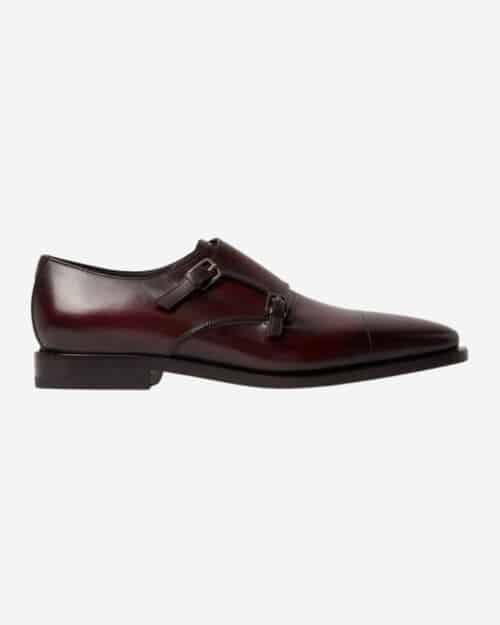
If whole-cut Oxfords are your thing (and why wouldn’t they be?), then you can’t do much better than a trip to Berluti, the renowned French shoemaker with a history dating back to 1895.
Founded by Alessandro Berluti, the brand is known for its exceptional craftsmanship and artistic approach to shoemaking. Berluti gained fame for its pioneering use of hand-applied patinas, creating unique and vibrant colourations on its dress shoes, and more recently, luxury sneakers.
Santoni
When you want your dress shoes to have a little Italian flair and flamboyance then you should visit Santoni, the Italian luxury shoemaker founded in 1975 by its namesake Andrea.
The family-run brand is renowned for its artisanal approach and impeccable craftsmanship, epitomised by its double monks, which are a work of art with their stunning patinas.
The new Andrea tassel loafer is also a sight for sore eyes, available in both leather and suede options.
Church’s


Church’s, now owned by Italian fashion house Prada, is yet another of Northampton’s finest, with a long and decorated history dating back to 1873.
The brand is renowned for its classic English designs, particularly Oxford and Derby silhouettes. With superior leather selection combined with handmade manufacturing processes, Church’s shoes remain a symbol of British elegance and heritage.
One of our favourite styles is the Horsham Derby with brogue detailing, which really captures the heritage of shoemaking in a very modern silhouette.
J.M. Weston
Founded in 1891, J.M. Weston is a prestigious French shoemaker perhaps best known for its iconic ‘180’ loafer, characterised by its distinctive metal saddle strap.
To this day, Weston’s shoes are still meticulously handmade in Limoges, France using the finest leathers and materials. In fact, a word on its leathers: what’s unique about J.M. Weston is the tanning of its leather, with the brand using a centuries-old method to develop a stunning depth in tone.
Add to that the incredible patinas, and you have a luxurious shoemaker at the top of its game.
Salvatore Ferragamo
Salvatore Ferragamo made his name in Hollywood in the 1920s producing stylish yet comfortable shoes for the world’s leading actresses, most notably his own brand of bow pumps.
He founded his eponymous brand on his return to his home town of Florence in 1927, carving a name for himself due to his exquisite leathers and meticulous craftsmanship.
The men’s collection all too often takes a back seat to the ladies’ footwear but it is sublime, particularly the extensive loafer offering that features an array of tassel, penny and horsebit designs.
Joseph Cheaney & Sons
With nearly 120 years of heritage under its belt, Northampton-based shoemaker Joseph Cheaney & Sons continues to ensure its legacy and reputation for producing timeless footwear thanks to an exquisite collection of Goodyear-welted shoes.
Handcrafting both city dress shoes and more rugged country designs, its semi-brogue styles really show off the brand’s expertise, while the Knightsbridge Oxford is a thing of beauty.
Ludwig Reiter
Ludwig Reiter is an Austrian shoemaker founded in 1885 in Vienna. It is renowned for its exceptional handmade craftsmanship and use of the Goodyear-welted construction method.
The company is still family-owned, preserving its heritage and commitment to quality. It produces all of the classics and then some, with some really interesting twists on traditional dress shoes.
Don’t expect shoes with overly ornate embellishments or bells and whistles – this Austrian legend does simple and classic to the highest possible level.
Paolo Scafora

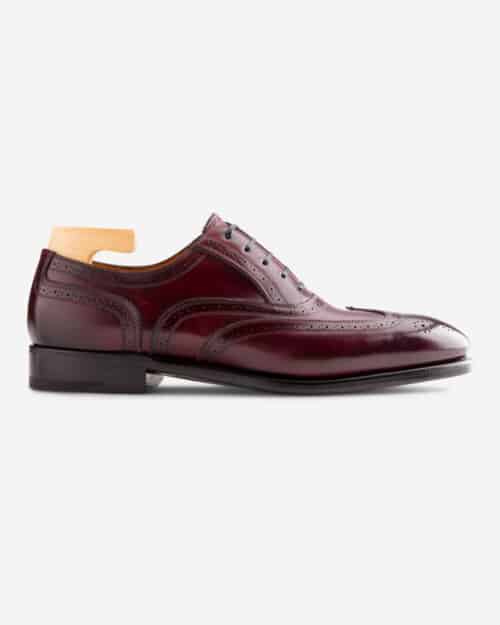
Founded in 1956 in Naples, Paolo Scafora shoes are entirely handmade using the finest leathers and materials. The company is family-owned, and Paolo Scafora himself oversees the production, ensuring the highest standards are maintained.
The shoemaker is esteemed for its use of bold colours and unique patinas, so is a great option for anyone looking to make a statement with their dress shoes.
Everything is made to order, with customisable details, too, and there is a bespoke process for those who want the very finest expression of handmade craft.
Carmina
The island of Mallorca has long been Spain’s shoemaking Mecca, and Carmina, founded in 1866, is the industry’s most famous export.
It specialises in Goodyear-welted construction, handcrafting each pair using the finest leathers sourced from around the world.
The family-owned business is currently managed by the fourth generation, and has built a reputation for its meticulous attention to detail, versatility in styles, and the ability to blend classic and contemporary elements seamlessly.




















